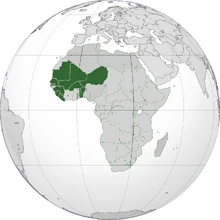| |||||||
The Federation of West African States, officially known as the WAF, short for the Western African Federation, is a pan-Africanist supranational economic, military and political union between 12 sovereign nations in West Africa. Unlike similar organizations in the rest of the African continent (e.g. SADC), this union is far more united and integrated together (despite its youth), with its own constitution, currency and parliament. This Union's geopolitical composition is comparable to that of the European Union (EU). As per the Treaty of Bamako, this federation was officially formed on September the 6th, 1996, in an effort to battle persistent French neo-colonial influence in the continental region of Western Africa, as well as to encourage its infrastructural, industrial and economic development. As per the Constitution of the Federation of West African States, which was drawn up on June the 5th, 2000, and ratified on September the 17th, 2000 by the Congressional Chamber of West Africa (the union's parliament), the federation's goal is to successfully form a sovereign union (similar to the USA and the USC) by 50 years time, and as a result, under this constitution, each member-state is to hold a national referendum to this effect in 50 years time (i.e. September 2050), and via a simple majority, each member state will determine whether or not it will be a part of this sovereign union. As a result, as of now (2015), the Union is made up of sovereign nations, each with a right of self-determination internally, although accountable to the Federation's rules.
The federation is currently made up of over 12 nation-states (Mauritania; Mali; Niger; Benin; Togo; Liberia; Sierra Leone; Guinea; Gambia; Senegal; Burkina Faso; Cape Verde), with the newly built sprawling metropolis of Fitowarana (literally meaning "Rising Sun" in the African language of Hausa) in the coastal belt of Mauritania, being the capital of the union. Even though the WAF came into existence due to constant French sponsored coups and EU supported destabilization initiatives in the region, the union is largely regarded as a "successful project of the United States of Columbia", as it was Columbian protection, funding and support that guaranteed the stabilization of its subsequent member-states. The fact that black people form one half of the USC's majority is thought to be one of the main driving forces behind the massive support the WAF received from one of the world's two Superpowers, and the 2003 CS-WAF Conference of Unity in Victoria City, USC, stands as the officialization of this alliance between the United States of Columbia and the Western African Federation. Due to the conference of 2003, Columbian troops are in every WAF member-state, with the USC having created multiple military bases within the federation. This means that the latter conference not only guaranteed the WAF financial aid and strong economic ties with the USC, but it also guaranteed its security, with Columbia not only burdening the continental region's defense (taking into account the 303,788 Columbian troops in said region), but its funding as well.



